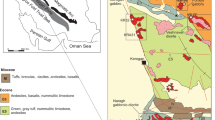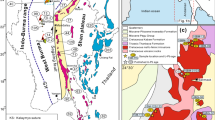Abstract
The plutonic complex of the Meissen massif (northern margin of the Bohemian massif) comprises dioritic to mainly monzonitic and granitic rocks. The diorite to monzonite intrusions show major and trace element patterns typical for shoshonitic series. The chemical signatures of less crustally contaminated diorites are similar to arc-related shoshonitic rocks derived from continental lithospheric mantle (CLM) sources previously enriched by subduction of altered oceanic crust. Laser step heating 40Ar/39Ar analyses on actinolitic to edenitic amphiboles from geographically different occurrences of the monzonitic intrusion yielded concordant plateau ages as well as total gas ages ranging from 329.1±1.4 to 330.4±1.4 Ma and from 330.4±2.1 to 330.6±1.8 Ma, respectively. These cooling ages are indistinguishable from sensitive highresolution ion microprobe (SHRIMP) 238U/206Pb intrusion ages measured on magmatic zircon rims from the monzonite (Nasdala et al., submitted). This shows that the monzonite intrusion is probably not related temporally to active subduction because it postdates eclogites of the adjacent Saxonian Erzgebirge by approximately 20 Ma. The shoshonitic magmas intruded during strike-slip tectonism along the Elbe valley zone. The enrichment of their mantle sources may be of Upper Devonian/Lower Carboniferous age or older. Intrusions of shoshonitic to ultra-potassic (K-rich) rocks during the Upper Visean/Namurian are widespread in the Moldanubian zone. Based on similar ages and structural relationships a similar post-collisional setting to the Meissen shoshonitic rocks can be demonstrated. Most of these occurrences cut high-grade nappe units which were subducted during the Upper Devonian/Lower Carboniferous. In contrast to the Meissen massif, at least the ultra-potassic members of the Central and the South Bohemian batholiths were derived from CLM sources enriched by fluids or melts released from subducted oceanic crust and by greater portions of crustal material. Despite the similar post-collisional geodynamic setting of the K-rich intrusions, different enrichment processes generated mid-European Hercynian CLM sources with heterogeneous major and trace element and isotopic signatures.
Similar content being viewed by others
Author information
Authors and Affiliations
Additional information
Received: 19 April 1996/Accepted: 25 November 1996
Rights and permissions
About this article
Cite this article
Wenzel, T., Mertz, D., Oberhänsli, R. et al. Age, geodynamic setting, and mantle enrichment processes of a K-rich intrusion from the Meissen massif (northern Bohemian massif) and implications for related occurrences from the mid-European Hercynian. Geol Rundsch 86, 556–570 (1997). https://doi.org/10.1007/s005310050163
Issue Date:
DOI: https://doi.org/10.1007/s005310050163




